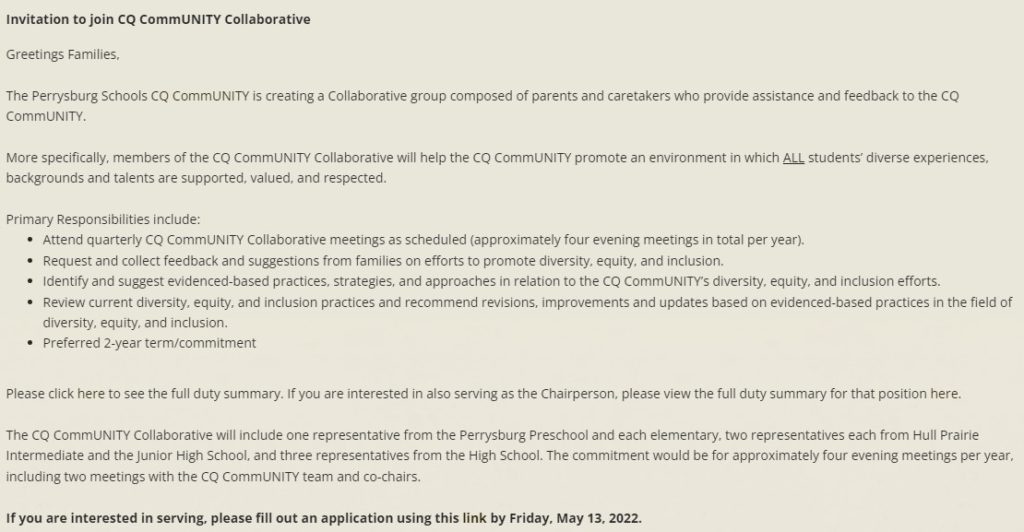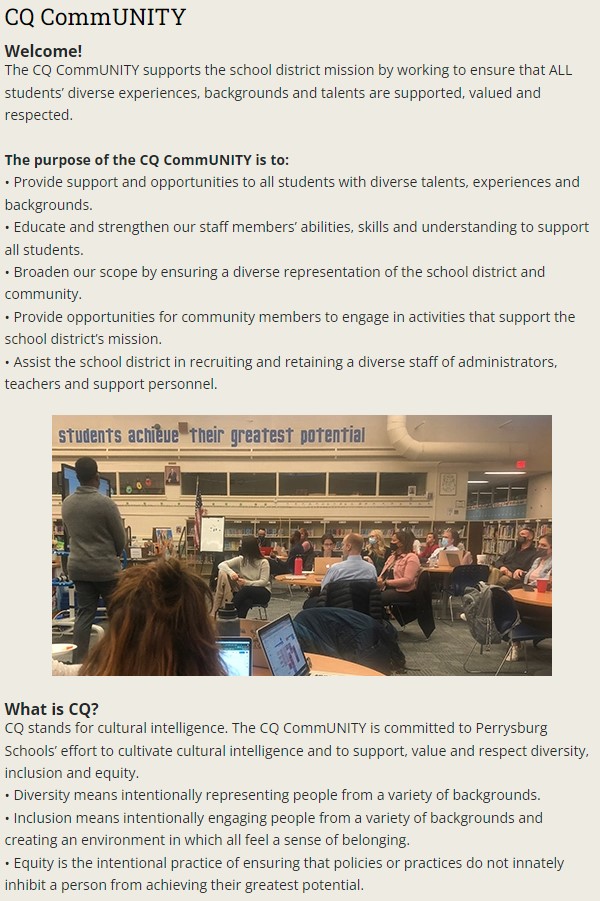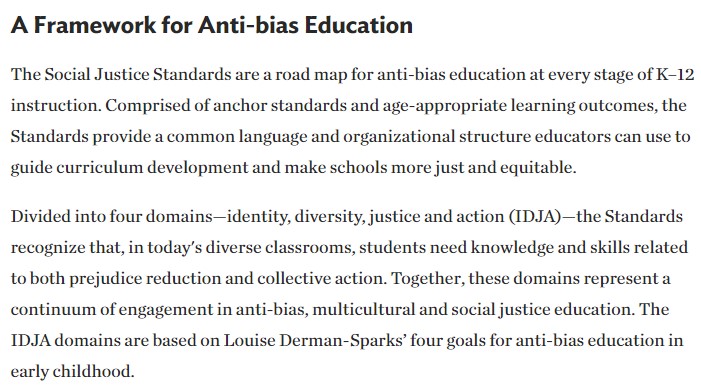
Perrysburg Schools asks teachers and students to complete Panorama surveys; school district intends to change curriculum to implement SEL and an “inclusive perspective”
Incidents
Perrysburg Schools is providing teachers and students with Panorama surveys in an effort to better implement Social Emotional Learning (SEL) in the school district. Three surveys are provided for grades K-2 teachers, grades 3-5 students, and grades 6-12 students. The school district explained the goals of the Panorama surveys and implementation of SEL to parents in a letter. The surveys will be conducted on May 16-20, 2022. The school district stated:
The importance of Social and Emotional Learning has dominated discussion within the educational community since the very start of our COVID-19 experience. These sentiments were shared by our staff members when surveyed in the second half of the 2020-2021 academic year. Concern for student well-being and the doubling of our local chronic absenteeism (from 5.1% in 2019 to 10.8% in 2021) adds to this growing concern. The implementation of a formal Social and Emotional Learning screener and the resulting conversations is an incredible opportunity for us to examine the school environments and activities we want to create to continue to best serve the needs of our students.
When explaining how the data from the Panorama surveys will be used, the school district explains that “our work is done in collaborative teams” and that there are “building leadership teams (BLTs) and teacher-based teams (TBTs).” These teams will use the data to focus on the following “four guiding questions”:
- What areas jumped out as needing our attention the most?
- As a group/team/grade level, are there areas that surprised us?
- Are there students that we need to have more information on as a result of this data?
- As a result of this data, what adult behaviors do we need to implement to provide a supportive environment for ALL students?
The survey for K-2 teachers asks the following questions about students:
- During the past 30 days, how considerate was this student of his/her classmates’ feelings?
- Overall, how much effort does this student put forth during your class?
- Overall, how much effort does this student put into figuring out what you are thinking?
- How often is this student able to control his/her emotions when s/he needs to?
The survey for grades 3-5 students asks the following questions:
- How carefully did you listen to other people’s points of views?
- How much did you care about other people’s feelings?
- How well did you get along with students who are different from you?
- How clearly were you able to describe your feelings?
- To what extent were you able to disagree with others without starting an argument?
The survey for grades 6-12 students asks the following questions:
- How carefully did you listen to other people’s points of view?
- How often did you care about other people’s feelings?
- How clearly were you able to describe your feelings?
- During class, how hard do you try to understand what your teachers are feeling?
- When your teachers seem to be in a worse mood than usual, how hard do you try to understand the reasons why?
Panorama Education Inc. is an organization known for helping schools throughout the country survey the race, ethnicity, sexual orientation, and gender identity of students in an effort to push “equity and inclusion” in school systems. The organization offers an “Equity and Inclusion Survey” to “help schools and districts track the progress of equity initiatives through the lens of students and staff, identify areas for celebration and improvement, inform professional development, and signal the importance of equity and inclusion to the community.”

The school district appears to have an equity parent group in an effort to “promote an environment in which ALL students’ diverse experiences, backgrounds and talents are supported, valued, and respected.” The school district also has a document detailing the responsibilities of this group. Responsibilities include:
- Request and collect feedback and suggestions from families on efforts to promote diversity, equity and inclusion, e.g. host an annual parent/guardian panel or forum.
- Identify and suggest evidenced-based practices, strategies and approaches in relation to the CQ CommUNITY’s diversity, equity and inclusion efforts.
- Review current diversity, equity and inclusion practices and recommend revisions, improvements and updates based upon evidenced-based practices in the field of diversity, equity and inclusion.
- Participate in applicable diversity, equity and inclusion school training and/or presentations.

The school district appears to have an equity program called “CQ CommUNITY.” The school district’s website explains that “the CQ CommUNITY is committed to Perrysburg Schools’ effort to cultivate cultural intelligence and to support, value and respect diversity, inclusion and equity.” The school district then lists several goals for the “CQ CommUNITY” to achieve:
- Provide support and opportunities to all students with diverse talents, experiences and backgrounds.
- Educate and strengthen our staff members’ abilities, skills and understanding to support all students.
- Broaden our scope by ensuring a diverse representation of the school district and community.
- Provide opportunities for community members to engage in activities that support the school district’s mission.
- Assist the school district in recruiting and retaining a diverse staff of administrators, teachers and support personnel.

The school district has a document detailing the history of the “CQ CommUNITY” program. The first event in the “2014-2015” timeframe is “Superintendent Diversity Committee founded to conduct School Climate Survey.” The first event in the “2016-2017” timeframe is that the school district “provided staff education by emailing multicultural calendars to staff monthly.” In the “2019” timeframe, the school district “partnered with the Perrysburg Coalition of Inclusion and Social Justice for a district-wide book.” In the “2020” timeframe, the school district “restructured Work Groups to address diverse needs of students: Disability, LBGTQIA+, Race/Ethnicity, Religion, Socioeconomic.”
The Perrysburg Coalition for Inclusion and Social Justice’s website describes the organization as “a group of community members working to secure racial equity in all aspects of life for everyone in Perrysburg, OH.” The organization continues to explain on the website that “we will accomplish our goals by advancing the needs of Black people, people of color, immigrants, and people of diverse cultures through a community-centered approach rooted in heeding the leadership of disenfranchised communities.” The organization then specifically mentions “education policy” as an area to target.

The organization also has a resources page on its website to help others push for equity. Resources on this page include the books White Rage: The Unspoken Truth of Our Racial Divide, A Queer History of the United States, I’m Still Here: Black Dignity in a World Made for Whiteness, Black Feminist Thought: Knowledge, Consciousness, and the Politics of Empowerment, White Fragility: Why It’s So Hard for White People to Talk About Racism, and How to Be an Anti-Racist.
The Perrysburg Coalition for Inclusion and Social Justice also promotes The New York Times‘ “1619 Project.” The 1619 Project is an attempt by The New York Times to rewrite history in an effort to falsely claim that America was founded in 1619 to represent “when enslaved Africans first arrived in what would become the United States.”
The organization also promotes Learning for Justice’s podcast Queer America. Learning for Justice is an organization known for pushing its “Social Justice Standards” to be adopted in schools throughout the country. The document for these standards includes goals to achieve for students. One goal is that “students will develop language and historical and cultural knowledge that affirm and accurately describe their membership in multiple identity groups.” Another goal appears to outright state that the purpose of the “Social Justice Standards” is to turn students into political activists: “Students will make principled decisions about when and how to take a stand against bias and injustice in their everyday lives and will do so despite negative peer or group pressure.”






The school district also has a monthly “CQ Community Newsletter.” The November 2021 newsletter specifically mentions “Transgender Remembrance Day.” The May 2022 newsletter specifically mentions “LGBTQIA+ Pride Month.”
On June 19, 2017, the Board of Education passed a “Multicultural/Inclusion Education” policy. The purpose of the policy is to change the school district’s curriculum to include an “inclusive perspective.” The policy states that “infusion of specific content throughout the District’s curriculum will promote acceptance, understanding, cooperation, and appreciation of diverse groups of people.” The policy also appears to mandate training for teachers on the issue by stating that “staff should receive professional development training which will enable them to foster understanding, acceptance, and positive relations among people of different backgrounds.”
On July 19, 2021, the Board of Education revised the “Nondiscrimination and Access to Equal Educational Opportunity” policy. The policy appeared to be updated to additionally include “gender identity” as a protected class. The revised policy also explains that the curriculum will be reviewed and updated: “Review current and proposed courses of study and textbooks to detect any bias based upon the Protected Classes; ascertaining whether or not supplemental materials, singly or taken as a whole, fairly depict the contribution of both genders, various races, ethnic groups, etc. toward the development of human society.”
The policy further explains that there will be additional training for school district staff: “Develop an ongoing program of in-service training for school personnel designed to identify and solve problems of bias based upon the Protected Classes in all aspects of the program.”
On July 19, 2021, the Board of Education appeared to revise the “Nondiscrimination and Equal Employment Opportunity” policy to also include “gender identity” as a protected class. The policy states: “The Board of Education does not discriminate on the basis of race, color, national origin, sex (including sexual orientation and gender identity), disability, age, religion, military status, ancestry, genetic information (collectively, ‘Protected Classes’), or any other legally protected category, in its programs and activities, including employment opportunities.”
The school district appeared to perform an “Equity Study of AP/Honors Course Selections” that is dated March 15, 2021. The report breaks down students in classes by “ethnic diversity percentages.” Categories of students include “Asian,” “Black,” “Hispanic/Latino,” “American Indian/Native,” “Multi-racial,” “Hawaiian/Pacific Islander,” and “White.”
Stay Informed
